Mary Bowron 1933-2017
by Catherine White and Warren Frederick
[Published in The Log Book, #75, pp 28-33, 2018]
[With some additional images]
Mary Bowron (1933-2017) grew up in Alabama, Mississippi and Louisiana and began potting in the early 1960's in southern California before moving to Maryland.
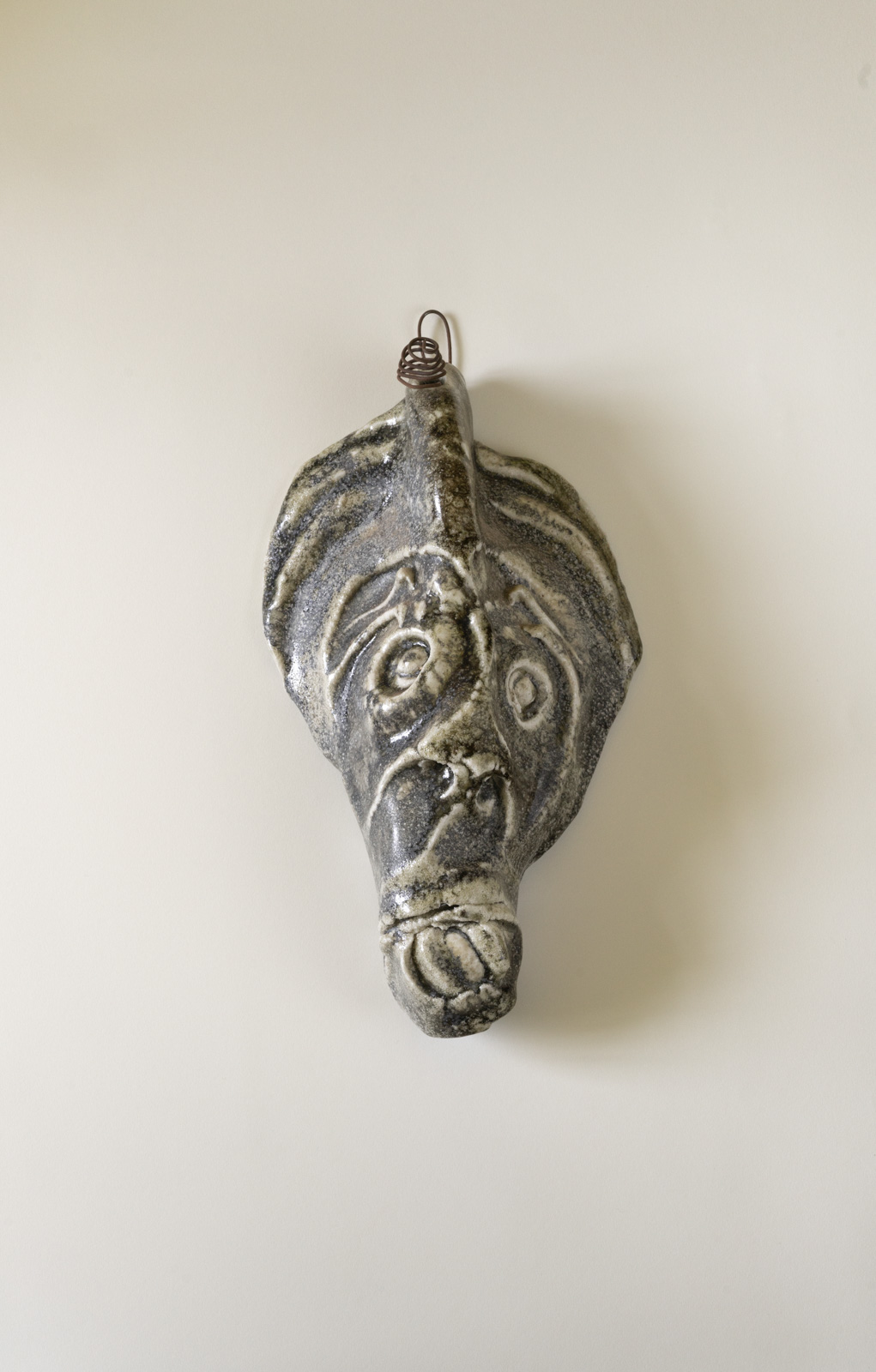
Mask, h 12.5" w 7" d 4"
What set Mary Bowron apart was her love of expression and her avoidance of the easy, appealing solution. Never quite satisfied with the forming method, the clay, the glaze, or the kiln, she would investigate the next question in terms of materials or firing or making raw prints with clay on paper. When she was wedging an iron bearing clay and saw intriguing marks left behind on the table, she asked, "what paper could I use to capture and amplify that?" When marks looked like birds or fish or horses she transformed these inklings into prints and paintings. Mary paid exquisite attention to how clay moved, what it left behind, and where it was going.
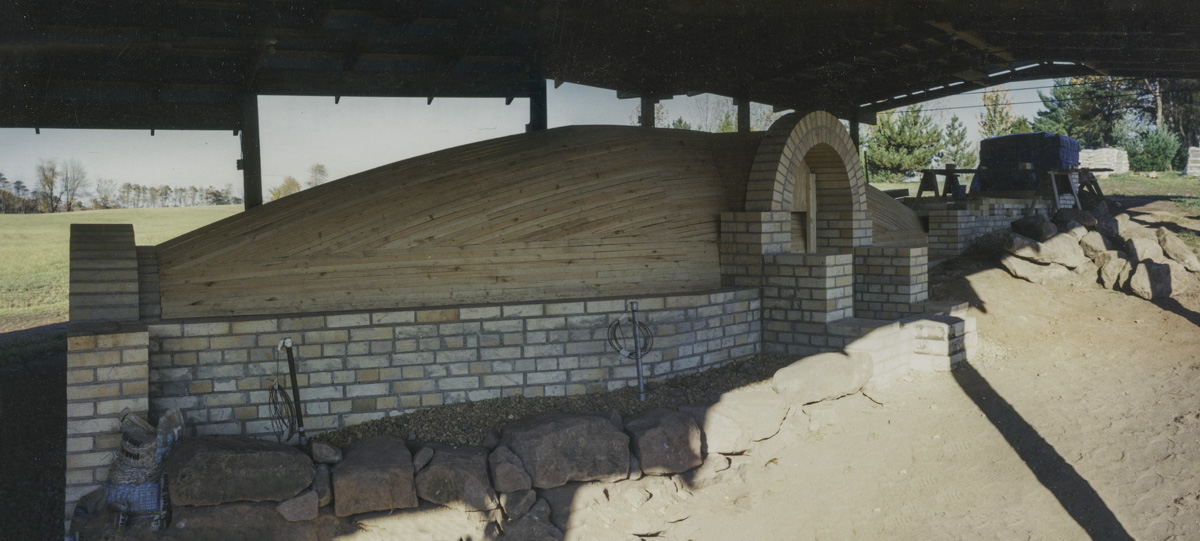
Initial formwork for cast arch, 11/1997
When Mary was in her sixties and she decided to build a wood kiln her relentless curiosity became especially apparent. She visited many wood kilns in her area. She called well-known wood firing potters to pick their brains. She read articles, looked at pictures, and found plans. Friends who had lived in Thailand gave her books to investigate the history of Thai-style kilns. Compulsive in her varied ways of collecting information, the results, often conflicting, forced her to forge her own answers.

Mary and Warren talking after completion of the castable arch, September 12, 1998. (Photo by Scott Meredith)
Warren (my potter-husband) and I talked to her many times during the planning process. We were floored by her ultimate plan to build a 40-foot long anagama-style kiln. But Mary had always been one to indulge her need for space and equipment. With a bad back she knew she wanted to be able to stand up in the kiln. That forced her to design large. Mary was also particular about process. At the front of the kiln she incorporated a gracious closed shed with a kitchen. The striking, multi-stepped roof had a gable door that could be opened so she could see the nature of the chimney smoke or flame while standing at the kiln mouth. There were multiple thermocouples to which she could attach pyrometers. When she dug the foundation, despite the fact that she hit rock, her chosen location was sacrosanct so she kept going.

Kiln shed, view before cast arch and chimney
November 1997
When we cast the arch for our kiln she was present not to help but to experience all the steps. She wanted to see how we measured and mixed our materials, to feel how we applied our castable balls over the arch form, to get a sense of pace. Mary had to get up close as if the smell of castable would transmit knowledge through osmosis. She digested the consistency and heft to gain an intuitive understanding of what the coordination of our team felt like so she could translate it into her own efforts.
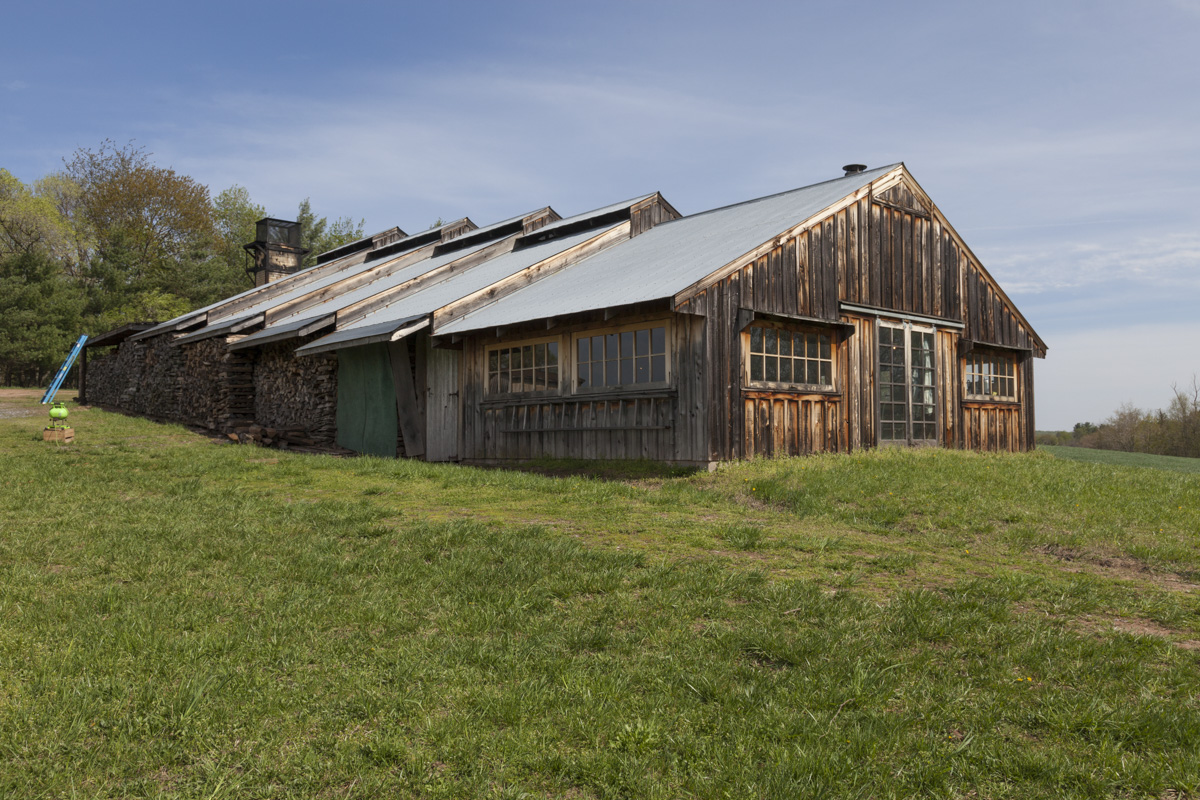
Mary Bowron kiln shed [April 2011]
Mary's anagama was sited in the middle of a gentle field about a five-minute walk from either the house or the studio. Robert Kelly, her long-time multi-talented assistant laid the brick for the kiln walls and chimney and built the elegant formwork for a castable arch. When we cast the arch in September 1998 we did it in one day with a crew of approximately forty volunteers, in one way or another all enamored with clay. Once in use, the long sides of the shed surrounding the kiln were permanently composed of stacked wood, neat piles of fireplace-sized logs and tall arrangements of narrow tobacco sticks. There were shelves holding molds, boxes filled with shells for stacking, and bone dry plates awaiting the next firing.
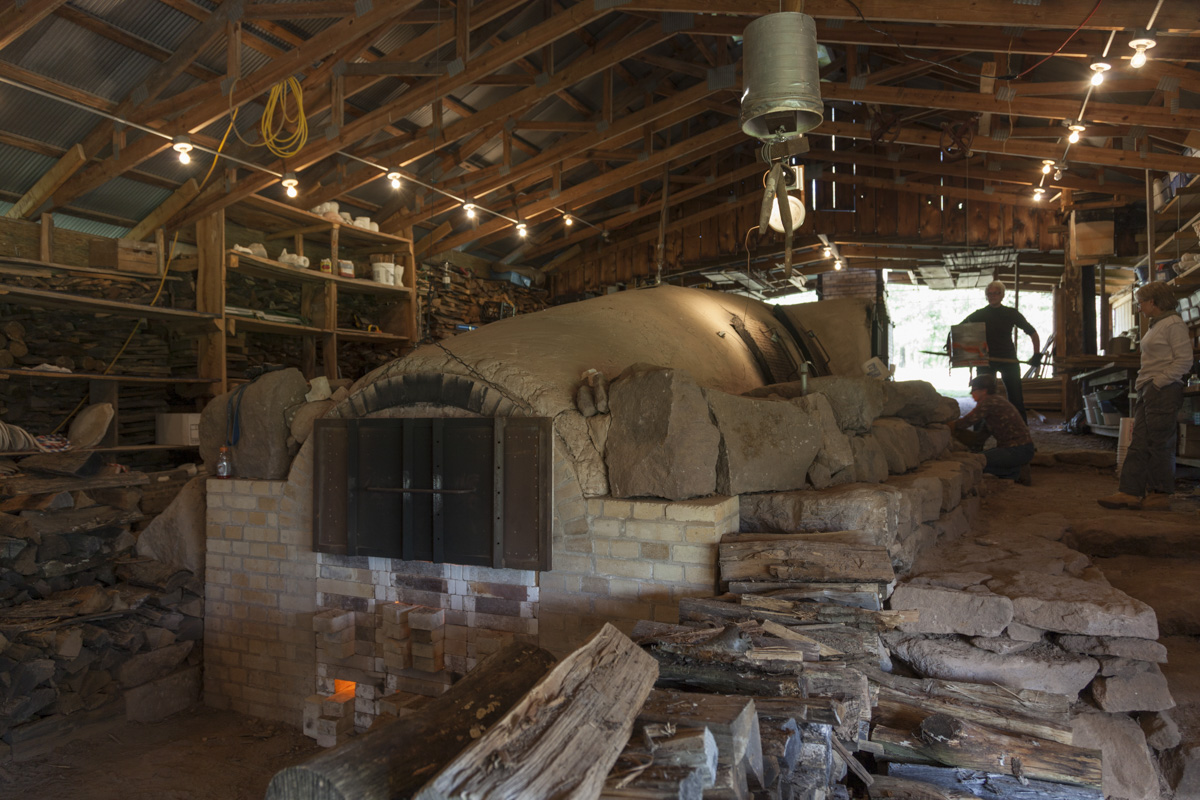
Mary Bowron firing April 2011
When I contemplated writing something about Mary Bowron I called one of her long time friends. She said, "You know, Mary would hate for anything to be written about her." That's true, but I think we need to verbalize how extraordinary Mary's commitment was to making and woodfiring in particular. When Mary was working in clay, making prints, or pots, or drawing it was as though through her hands she got closer to an understanding of the predicaments of life. She became intimate with how birds navigate or of a horse's instinctual fear or how fish remember where to spawn. My guess is that Mary wanted her work to speak outside the vocabulary of the written word. She aimed to capture the forces of life, nature and its inequities.

Mary Bowron Studio Wall Snippet
From the moment I moved to the Washington, DC area in 1979 Mary Bowron was someone who was part of my ceramic landscape. At first she was a mythical creature, the source of a friend's platter formed of dark clay with an ethereal bird painted in white slip. Later, I would visit her in Boyds, Maryland and everything about Mary’s compound had its own kind of geometry or algorithm of reason. The studio and showroom were in a weathered stone barn. A magical log cabin housed a library of children's books. There was an old gas station hose across the long entrance road that rang a bell in the studio and house when a vehicle arrived. Later she replaced that with a large hand-bell and a sign that read "ring bell and someone will appear or if not come again another day." The porches on her buildings were extra wide and encouraged a generosity of community. Mary's kitchen was in an old farmhouse with a woodstove covered with loosely made tiles. The shelves above the sink were piled with old work from the '70s and '80s. The wide wood table to the side was filled with fossils and wood fired plates. Covered with books, strewn with napkin and paper scrap bookmarks, the tide of the table was always a source of inspiration and conversation. Off of the kitchen she created a whole print studio with a high-tech press and sink where others might have had a conventional living room.
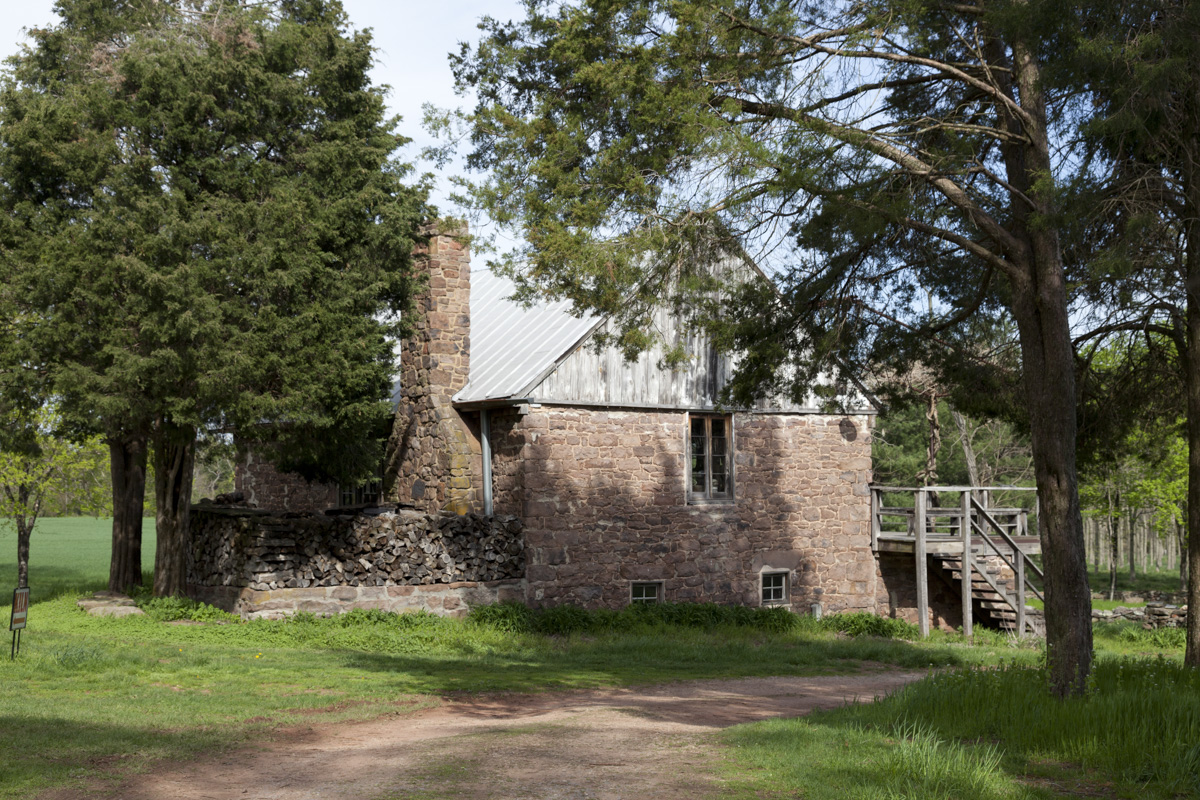
Mary Bowron's Showroom and Studio Barn, 2011
Mary had multiple outbuildings to energize her endless productivity. A bunkhouse hosted the rotating firing crew. Out in the corncrib barn there were working stands made of massive wooden stumps on casters, ten large metal woks for use as forms, and ropes strung from the rafters and tied to the sidewalls. In her fearless experimentation, Mary made one series where she attached clay forms to the ropes and then swung them to collide creating the imploded look she was after. She built a primeval stone circle that she used to pit fire ceramic heads before the wood kiln was built. At the entrance to the farm Mary planted a five-acre grove of Paulownia trees, which she initially nursed along by hand watering with buckets. Each invention of imagination or of technique had a reason, sometimes to imbed an emotion central to Mary’s persona or sometimes it was a physical solution to a problem. She knew how to invest in herself as an artist intent on her own path. This scaffolding made eminent sense to Mary whether or not others understood. This structure allowed her to be incredibly productive, an essential component of her strength
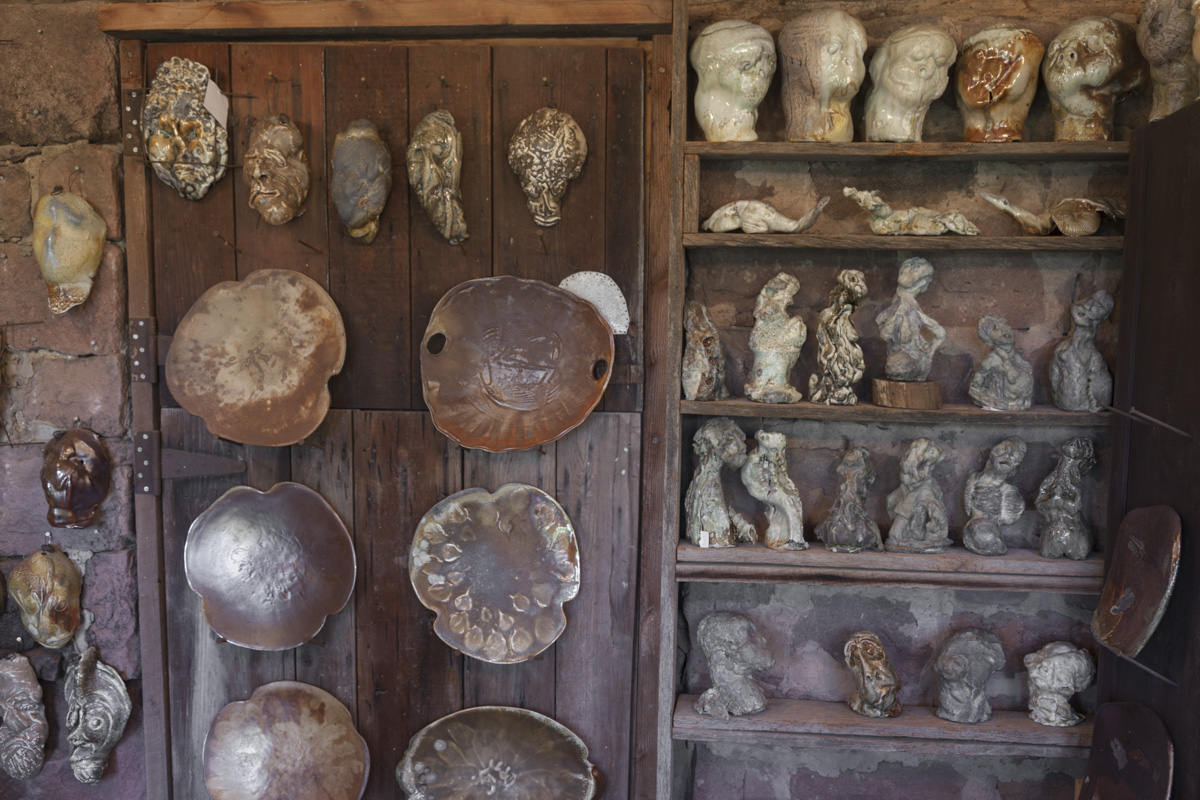
Showroom Display, 2011
Mary began in the 1960s by making a wide variety of functional items—platters, bowls, teapots, and tiles. Yet she was always one to innovate with clay and glaze materials, teasing out nuances while drawing, stretching and imprinting. Her expansive sense of clay's potentials flew under the radar of what anyone else imagined. Due to her fiercely self-reliant artistic life over these many years, Mary has been a true inspiration as an independent voice in ceramics. Mary was a lunar presence, reappearing on an unpredictable cycle. She visited my first professional studio in Maryland, our current one here in Virginia, and sometimes would appear when I was teaching in Maryland, forty minutes from her home. She was a friend who I talked to on the phone and compared notes on clays both wild and commercial. We planned future firings, and evaluated past ones. We had occasional play dates to explore a variation on an approach. We visited each other during firings although we were not part of each other’s firing teams. Every time we talked, visited, or made things together I came back to my own work inspired with a refreshed commitment.
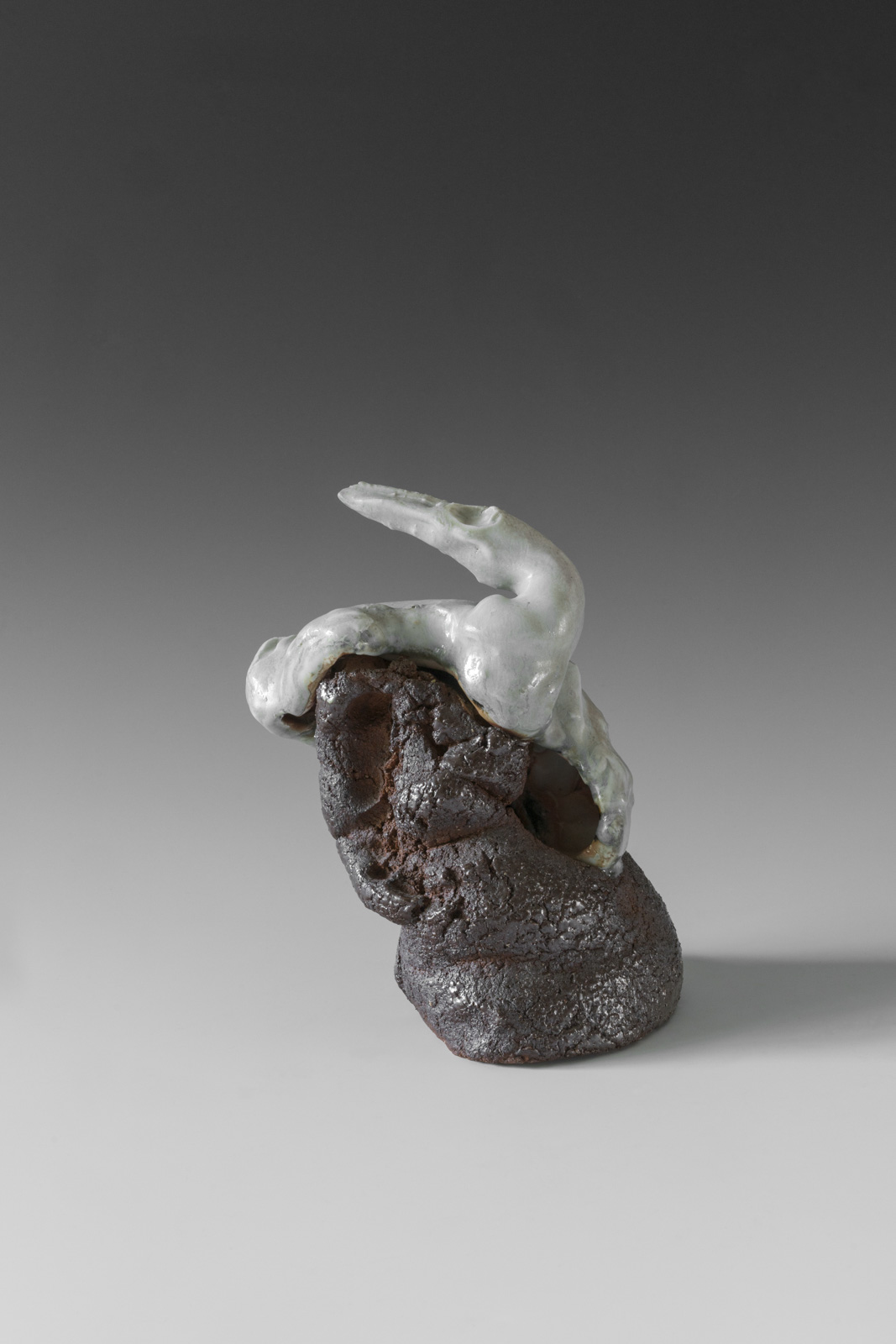
Bird on Rock (showing Mary’s eloquent use of wadding)
h 7.75" w 6.5" d 5"
Mary fired her large kiln for eight to fourteen days with many student and potter helpers all closely managed. I remember one time being in the house with her towards the end of a long firing. With a twinkle in her eye, she rubbed my back saying, “Come I'll take you in the studio and show you some stuff!” She explained which things I could pick up and which ones not to touch. “With potters," she said, "you’ve got to tell them not to pick up certain things. The rest of the world is too afraid to handle anything because they might break something.” Then we hopped in the truck, strewn with mail and cigarette butts, and drove to the kiln. As I stacked the mail and avoided the butts before sitting Mary pointed out “you know cleaning is not my favorite sport.” The kiln seemed calm with the team of eight following her very particular instructions. I said hi to the folks chatting, eating, and stoking. Satisfied with her team, Mary went back to the house to nap while I headed to the showroom of finished work to partake in silence.
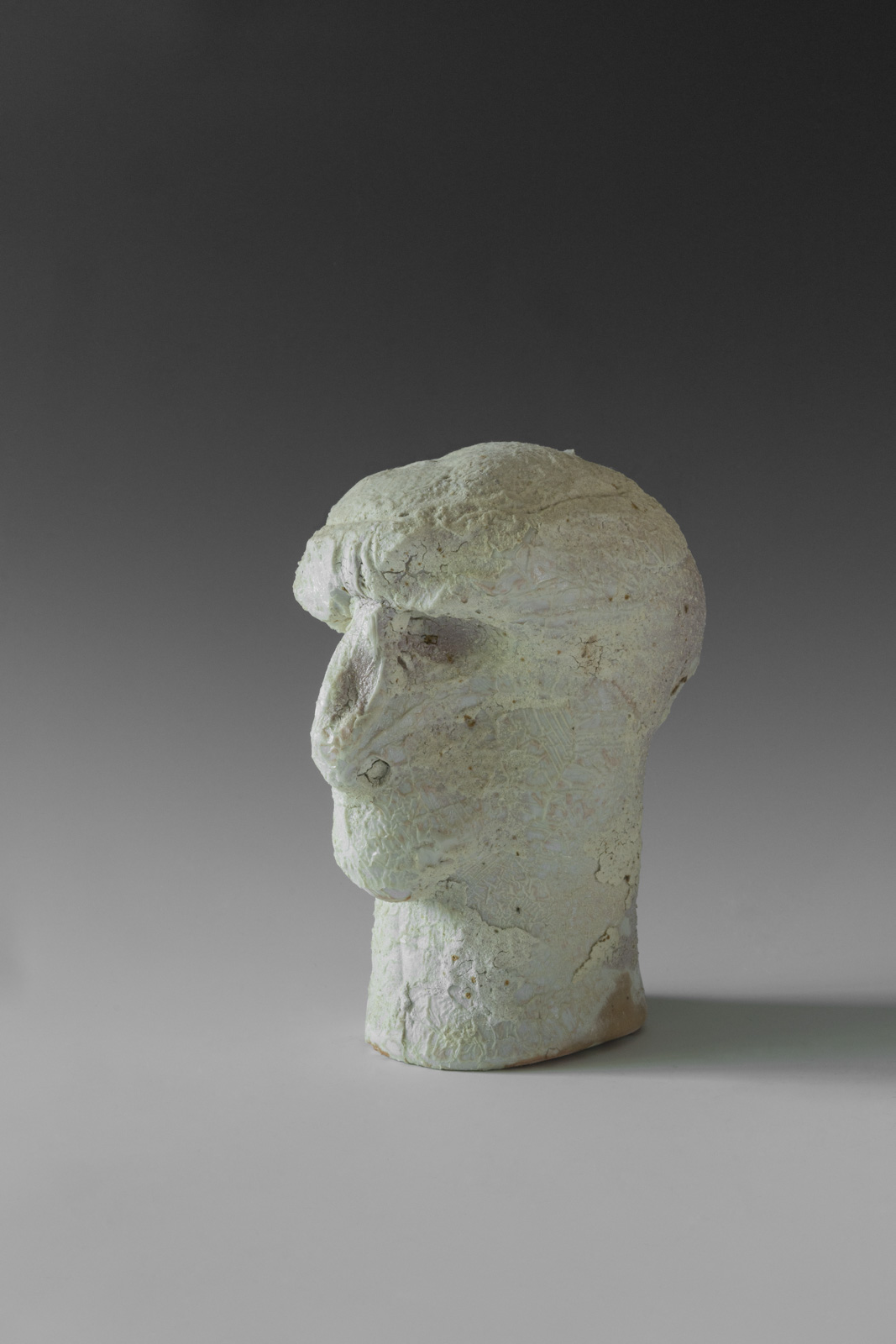
Head, h 9" w 5.25" d 7"
There were always so many objects to ingest it was hard to find the edges or the hierarchy of aesthetic ideas by which to sort the approaches. Occupying an entire wall her many, silent, mouth-less heads comprised one long-lived project sparked by her commitment to human rights and equality. The longer I contemplated the diversity the more I intuited her multifaceted search for an expressive voice of nature, pain, and the human or animal spirit through clay. When I ventured to the upstairs studio and sat at Mary's table in front of the fireplace, the piled books gave a sense of her aesthetic search, ranging from the history of horses to the paintings of Ben Shahn, from African masks to Martin Puryear's sculptures.
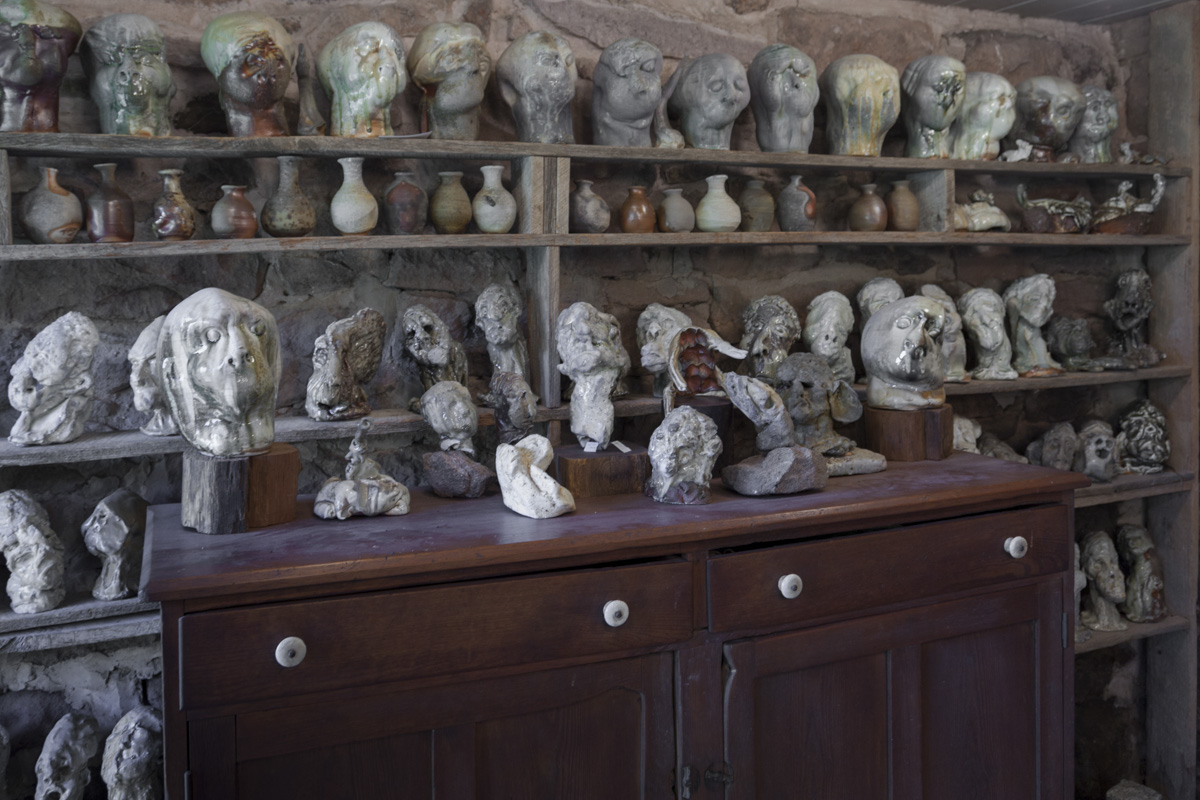
Showroom Display, 2011
As I have spoken to friends and family about Mary, over and over again people say Mary advised don’t always choose the pretty. She was after a sense of beauty beyond convention. Her heads, masks, and some of the birds or horse-like forms transformed her anger at injustice and her empathy for trauma, transmuting them into a powerful sacred rage. Over the last couple years of her life as Mary became bedridden I was impressed by how many people knew Mary, by how many people she had called over the years and picked their brains before and after she built her kiln. I was struck by how many of our colleagues and friends had stopped by to admire her kiln, work, and life and how often they were involved in responding to her many questions. On our visits during her last two years, even though at times language seemed to evade her tongue, Mary was still her sharp, assertive and funny self. During those visits when she was more communicative she still wanted to know what clays we were experimenting with and when we next planned to fire
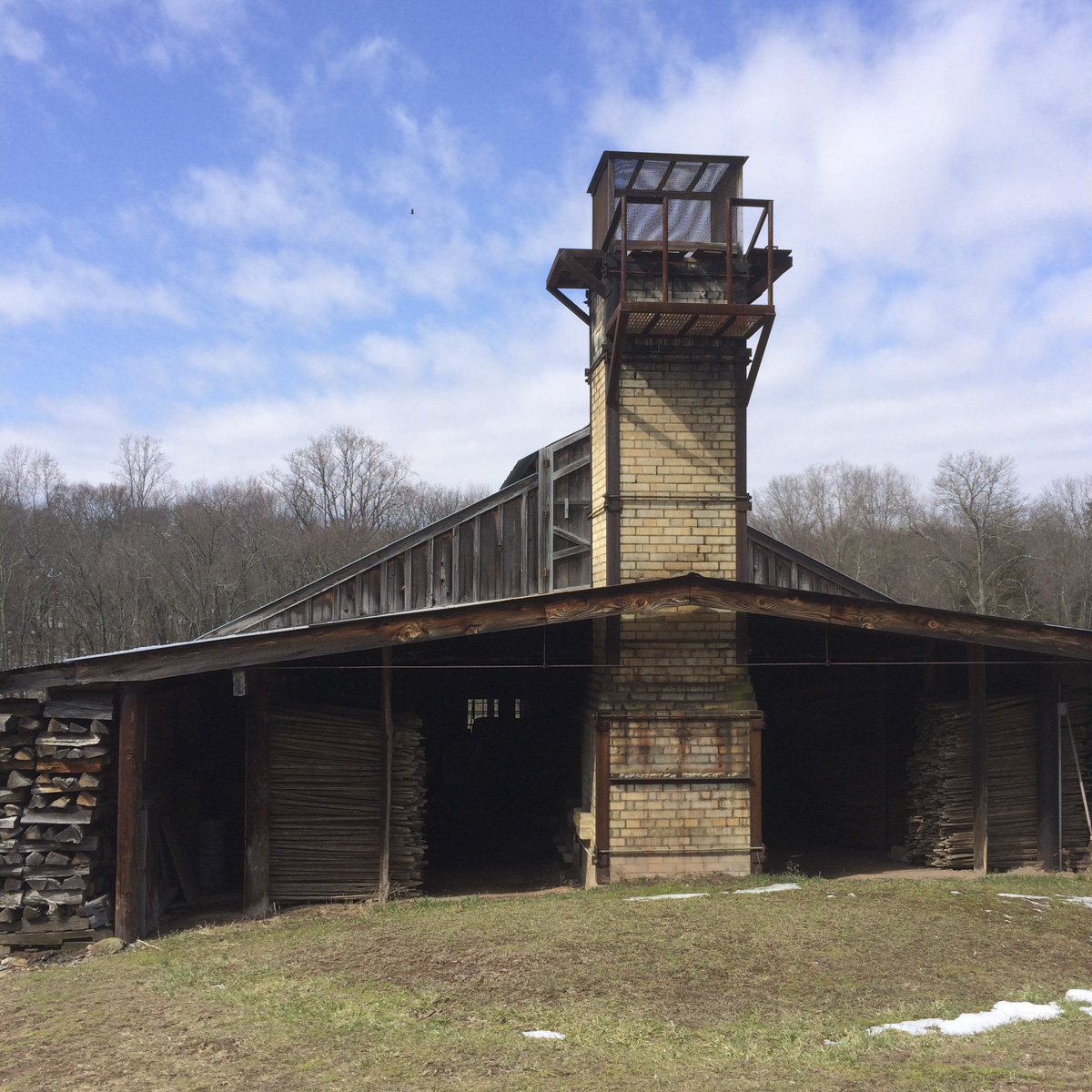
Mary Bowron Kiln Chimney (2017)
Mary had the energy of a super-focused animal spirit; she would tussle with an idea or gnaw on it like a dog with a bone. To feed the brainstorm she would endlessly experiment. Mary's gift was to create space for ideas to grow. She searched for the perfect tool to realize the vision that was still beyond the reach of a physical object. She had the energy and work habits to fill her massive whale of a kiln. When a firing was disappointing she leaned into the task to make more work and filled the kiln again. Mary never worried about an audience. I think, in truth, she was bewildered by the idea of self-representation as if discourse on the work would take the energy out of what should speak for itself. She concerned herself with what she imagined she could make and kept reaching for those embryonic images yet to be realized.
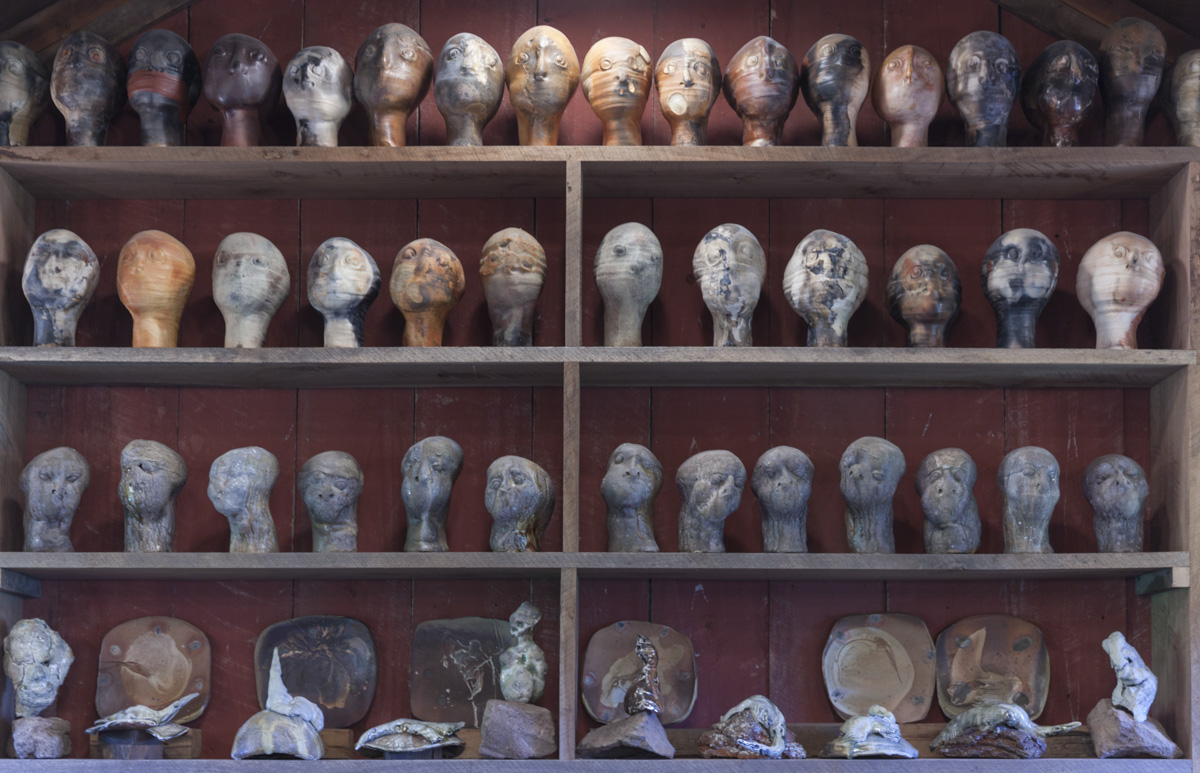
Wall of Silent Heads, Showroom Wall, 2011
It was as if Mary’s work was her own mother tongue. Though her large series of heads lacked mouths, they were eloquent as a "crowd of silence and fear." Mary evolved as an artist through both imagination and pure will. Her compassion for trauma cut her like a knife and she used that same knife as a tool, not a weapon. She understood gesture not just in a lyrical sense, but equivalent to the sharp potential of a knife. Her particular gift—to print, draw, slice, stab, cut, shape—to sculpt an authentic vocabulary of form and surface testifies to the empathy she felt for the abused and silenced. If we can all take a step beyond seeking the conventional pretty object, then Mary Bowron provides a truly inspiring model to emulate.